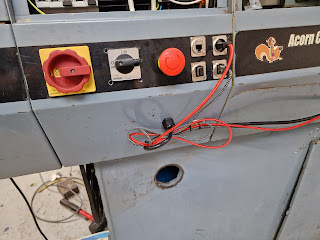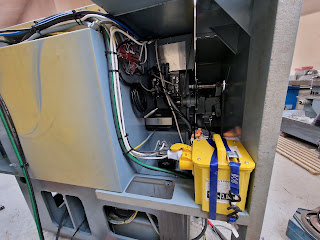I've been out of commission for the last few weeks. Pretty certain I had proper flu which obliterated 2 weekends, spent moping about in bed or staring into space, aching all over, hot and cold etc. 9 futile (negative) Covid tests, so it's almost certain I have still not yet caught it. Finally, 95% of the symptoms seem to have passed, so finally I can get back into the workshop and resume. Where were we?
Various tasks need to be completed before I can use the Tree. These arise from "just" refitting the enclosure, properly(?) wiring everything up and installing the remaining parts that would constitute a complete machine. These include (but are doubtless not exhaustive):
- Wiring up and plumbing up the coolant pump and its associated reservoir tank.
- Mounting and connecting up the monitor and mouse/kbd.
- Installing the 110V transformer (required for the hydraulic solenoids).
- Connecting up the internal (IP66) lights.
- Making up some form of tool touch-off probe for tool length / offset etc measurement.
- Sealing the headstock / bed covers to the enclosure.
- Cleaning up (and polishing?) the front and tailstock windows.
- Checking out / replacing the Meanwell PSUs that seem to be tripping the RCD. Or wiring up a 240V isolation transformer on the main incomer.
- Machining several toolholders down from 20mm to 3/4" height so that the tool tip is at centre height (part of this machine's imperial legacy).
- ...
Vertex coolant pump:
Let's start with the replacement coolant pump. The pump that cam with the machine can't have been the original, as it barely extended halfway down the reservoir, meaning I'd have to half fill the tank before I could even get anything to come out of the pump. So instead I've bought a new Vertex with the correct reach.
The hole is just too small for the pump to fit through. Also, the bolt PCB is slightly larger on the new pump, so I'll need to drill and tap some new holes.
The casters are completely buggered. I've ordered some replacements from some shitty ebay shop.
The remnants simply need to be cut and ground off.
Like this. With a coat of primer and paint to prevent undue rusting.
Here's the upper tray. It catches parts and swarf and allows the coolant to pass through a gauze into the main reservoir. Yes, it's been outside for a few months.
Let's fit the motor first. I'm going to refit the quick release hose coupling, so it makes sense to fit a plug / socket on the electrical supply. Simplest solution is to bang a hole in the cover and fit an IEC socket:
Not the prettiest job I've ever done but it does the job. The quick release hose coupling is also visible here.
Rather than weld the shitty new casters, I've decided to fix them to a piece of chipboard and simply drop the coolant assembly onto it for now. For one thing, the machine is sitting on bricks above its normal height, so the final position of the assembly may need to be fettled.
There. Now I "just" need to fit the pump to the tank.
Holes drilled and tapped M6. And 30 mins of my life spent with the grinder opening up the aperture so the pump will fit through.
Finally sorted.


















































